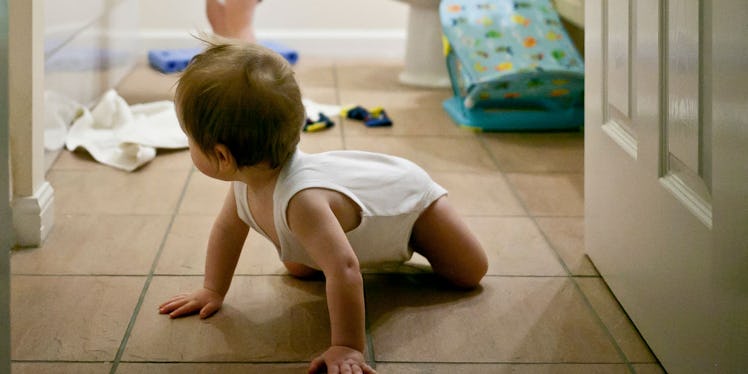How to Properly Disinfect Your Home Once Your Kid Starts Crawling All Over It
We asked a panel of doctors what it takes for parents to protect their homes from germs so mobile toddlers can healthily roam those hard to reach places.

The following was produced in partnership with Lysol, which helps parents keep their homes clean and disinfected so they can celebrate the explorative time when their baby begins to crawl and walk.
In many ways, toddlers are like sharks. Their sleep habits are mysterious. They can strike without warning (albeit with milder results). They explore their world through taste. And, once they start moving, they tend not to stop. Those last two traits in particular — mobility and an instinct to chew on everything — present new challenges for parents trying to keep their homes germ-free and their children healthy. That’s why parents should take care to follow these important household disinfecting measures as their crawling babies find their footing.
Get on Their Level
Part of what makes disinfecting problematic during this particular phase is that newly mobile toddlers tend to venture to places adults literally overlook. According to Dr. Samuel Altstein, a board-certified primary care and family medicine physician at Mount Sinai, if parents truly want to disinfect their toddler’s world, the first and most effective step is to see that world through a crawling baby’s eyes.
“Get down to their eye level. Have a seat on the floor and look around to see how they perceive space and place. You’ll see a lot more that will require your attention,” he says.
At the same time, a child’s tiny world gets a lot taller once they’re able to pull themselves up to a standing position and reach above their eye and head level. This means parents will have to turn their household disinfecting efforts towards freshly reachable things like drawer and cabinet handles, couch cushions, certain countertops, and even the underside of the coffee table.
Take Off Your Shoes
While they’re under the coffee table, parents will likely find themselves face to face with their family’s footwear, much like their crawling toddler often does. “Shoes bring in things from all over the place you may not see or even think about,” says Dr. Jennifer Trachtenberg, a fellow of the American Academy of Pediatrics.
University of Arizona environmental microbiology professor Charles Gerba was even more to the point: “About 90 percent of people’s shoes have fecal bacteria on the bottom and, surprisingly, about a quarter have E coli.” That stuff contaminates floors. Toddlers crawl on floors and then proceed to put their fingers in their eyes and mouths an insane 80 times per hour, by Dr. Gerba’s count.
Therefore, all of the doctors recommend that everyone removes their shoes as soon as they enter the home and leave them in a garage, mudroom, or closet. It’s an essential safeguard against exposing newly mobile kids to germs. As Dr. Altstein colorfully puts it, “Taking your shoes off and leaving them somewhere where the kid can’t go chew on them is a very good idea.”
Disinfect the Floor
Even the strictest no-shoes policy enforcers still must guard against the many delightful microbes a crawling baby drags around the house on (and in) their diaper. Therefore, the doctors say it becomes even more important to wipe floors down with a disinfectant to kill germs dead. They recommend once a day. That’s not always realistic, but try to do it as often as possible. And of course, use any disinfecting product as directed.
The doctors were less concerned with carpet because it’s a tough surface for microbes to transfer through. Dr. Gerba did recommend putting a clean blanket on carpeted floors for crawling babies as a precaution. It’ll also cover and protect against choking hazards that might drop from parents’ pockets. As for area rugs, go ahead and hit those with a disinfectant spray as often as you’re able.
Beyond that, Dr. Altstein simply says, “Clean anything that’s visibly dirty.” When fighting an unseen (and unseeable) enemy, it’s best to err on the side of standard good hygiene. With the floors disinfected, parents can feel pretty comfortable about letting kids move around.
Wipe Down Their Toys
The rule of thumb, which, along with every block, rattle, and train, will end up in a toddler’s mouth, is to clean all toys with a good disinfecting wipe or spray at least once a week. This is especially true as crawling babies become more mobile and start bringing toys with them to various indoor and outdoor spaces. “I think every soccer ball I’ve ever tested had E. coli,” says Dr. Gerba. Sharing toys is also a highly effective way to pass germs between toddlers; kids in daycares get more colds than kids in isolation. So wipe down all toys (and rinse with potable water) immediately after any play session as part of your household disinfecting routine.
Wash Your Hands
Hand washing is not specific to crawling babies, but it’s still a highly effective disinfecting measure all parents should take. Bacteria is most easily transmitted through touch, which means clean hands have less chance of contaminating surfaces kids will touch, crawl on, and lick. Why do they lick the walls? (They just do.) Three out of three doctors agree.
“I live in New York City so, despite my best efforts, I’ve touched 9 million people by the time I get off the subway,” Dr. Altstein says. “So wash your hands before you touch anybody or anything. Carry hand sanitizer and rub some on as you walk in the door.”
Household disinfecting for toddlers on the move starts with the floor. Like them, the task quickly grows. But following the doctors’ simple tips can help parents rest a little easier about their kids’ sudden ability to access those previously hard to reach places.
This article was originally published on